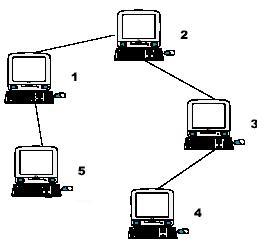Computer
Time Limit: 1000/1000 MS (Java/Others) Memory Limit: 32768/32768 K (Java/Others)Total Submission(s): 3972 Accepted Submission(s): 1989
Problem Description
A school bought the first computer some time ago(so this computer's id is 1). During the recent years the school bought N-1 new computers. Each new computer was connected to one of settled earlier. Managers of school are anxious about slow functioning of the
net and want to know the maximum distance Si for which i-th computer needs to send signal (i.e. length of cable to the most distant computer). You need to provide this information.

Hint: the example input is corresponding to this graph. And from the graph, you can see that the computer 4 is farthest one from 1, so S1 = 3. Computer 4 and 5 are the farthest ones from 2, so S2 = 2. Computer 5 is the farthest one from 3, so S3 = 3. we also get S4 = 4, S5 = 4.

Hint: the example input is corresponding to this graph. And from the graph, you can see that the computer 4 is farthest one from 1, so S1 = 3. Computer 4 and 5 are the farthest ones from 2, so S2 = 2. Computer 5 is the farthest one from 3, so S3 = 3. we also get S4 = 4, S5 = 4.
Input
Input file contains multiple test cases.In each case there is natural number N (N<=10000) in the first line, followed by (N-1) lines with descriptions of computers. i-th line contains two natural numbers - number of computer, to which i-th computer is connected
and length of cable used for connection. Total length of cable does not exceed 10^9. Numbers in lines of input are separated by a space.
Output
For each case output N lines. i-th line must contain number Si for i-th computer (1<=i<=N).
Sample Input
5 1 1 2 1 3 1 1 1
Sample Output
3 2 3 4 4
//这个题目我做了很久,自己也想了很久,每个点的最大距离,主要是搜索,只要这个领悟到了,做这道题应该不是很难,自己还是有很多不会的地方,我还是要多多锻炼。
#include <stdio.h> #include <stdlib.h> #include <iostream> #include <string.h> using namespace std; #define maxn 10010 struct node { int son; int val; int next; }; int max(int x,int y) { if(x>y) return x; else return y; } node p[maxn]; int head[maxn*2-1]; int vis[maxn]; int dp[maxn]; int downd[maxn]; int downx[maxn]; int pos; void add(int pa,int son,int v) { p[pos].son=son; p[pos].val=v; p[pos].next=head[pa]; head[pa]=pos++; return ; } void DFS(int fa) { int len=head[fa]; if(len==-1){return ;} int w=head[fa]; int max1=-1; int flag; while(w!=-1) { DFS(p[w].son); if(max1<p[w].val+downd[p[w].son]) { max1=p[w].val+downd[p[w].son]; flag=p[w].son; } w=p[w].next; } downd[fa]=max1; vis[fa]=flag; // printf("%d\n",flag); w=head[fa]; max1=-1; while(w!=-1) { if(p[w].son!=flag&&(max1<p[w].val+downd[p[w].son]||max1<p[w].val+downx[p[w].son])) { if(max1<downd[p[w].son]+p[w].val) max1=downd[p[w].son]+p[w].val; if(max1<downx[p[w].son]+p[w].val) max1=downx[p[w].son]+p[w].val; } // if(p[w].son==5) // printf("max1=%d\n",max1); w=p[w].next; } if(max1==-1) downx[fa]=0; else downx[fa]=max1; } void DFS1(int fa) { int w=head[fa]; while(w!=-1) { if(vis[fa]!=p[w].son) dp[p[w].son]=max(downd[fa],dp[fa])+p[w].val; else dp[p[w].son]=max(downx[fa],dp[fa])+p[w].val; DFS1(p[w].son); w=p[w].next; } return ; } int main() { int n; // freopen("in.txt","r",stdin); while(scanf("%d",&n)!=EOF) { int a,b; pos=0; memset(head,-1,sizeof(head)); memset(dp,0,sizeof(dp)); memset(downd,0,sizeof(downd)); memset(downx,0,sizeof(downx)); for(int i=2;i<=n;i++) { scanf("%d%d",&a,&b); add(a,i,b); } DFS(1); DFS1(1); for(int i=1;i<=n;i++) printf("%d\n",max(downd[i],max(downx[i],dp[i]))); } return 0; } /* 11 1 1 1 1 2 1 2 1 3 1 6 100 6 1 3 1 9 1 9 1 */





















 1581
1581

 被折叠的 条评论
为什么被折叠?
被折叠的 条评论
为什么被折叠?








